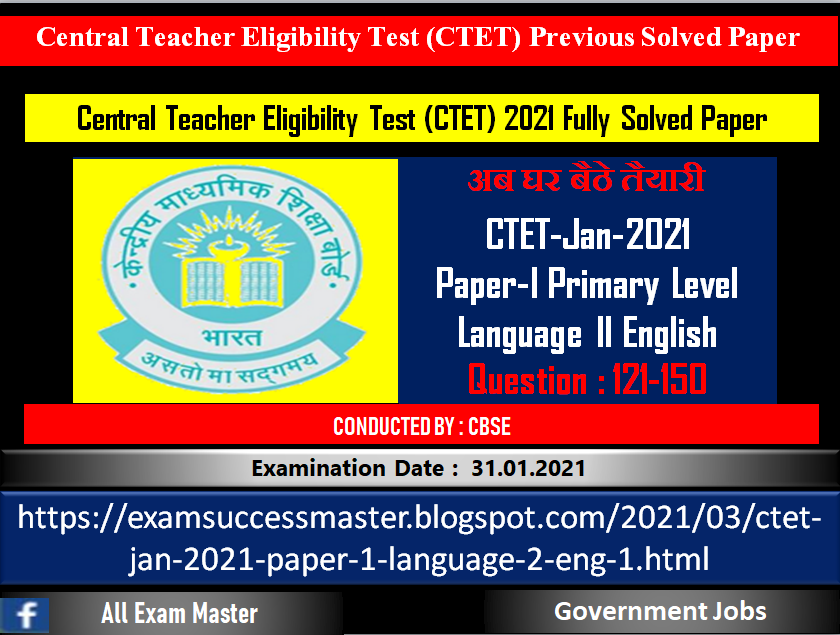CTET-Jan-2021 Paper–I Primary Level (Class 1 to Class 5) CDP solved paper
Welcome to our exclusive collections of CTET (Central Teachers Eligibility Test) exam old/previous fully solved question papers. All questions are of multiple choice type.These questions are very helpful for those candidates and aspirants who are preparing for the various government and non government exam as well as in interview.
Total Question: 150
Total Marks : 150
Exam Level: CTET Paper I Primary Level (Class I to V)
Time Allotted : 2 Hours and 30 Minutes
Conducted By: Central Board of Secondary Education (CBSE)
Exam Date : 31th Jan-2021
CTET Exam Jan-2021 Paper – 1 (Primary Level) Part – V Language – II Hindi (भाषा – II हिंदी)
Question : 131-140
दिए गए अनुच्छेद को पढ़कर पूछे गए प्रश्नों (प्रश्न सं. 129 से 135 तक) के सही / सबसे उपयुक्त उत्तर वाले विकल्प चुनिए :
चिनार वृक्ष सामान्यतया मध्यम आकार के, मध्यम से अधिक ऊँचे आकार के होते हैं । इनकी ऊँचाई 50 मीटर अथवा इससे भी अधिक हो सकती है। इसकी लकड़ी का घनत्व बहुत अधिक होता है तथा यह मजबूत और कठोर होती है । चिनार की लकड़ी सफ़ेद होती है तथा इसके किनारे पीले अथवा लाल रंग के होते हैं। इसकी लकड़ी पर सरलता से पॉलिश की जा सकती है तथा रंग भी किया जा सकता है। इसकी लकड़ी न तो आसानी से कटती है और न आसानी से टूटती है । किंतु यह टिकाऊ भी नहीं होती है, अत: कीमती फ़ीचर आदि इससे नहीं बनाए जाते। चिनार वृक्ष का तना सुंदर और आकर्षक होता है एवं इस पर काँटे नहीं होते, किंतु छूने पर यह खुरदुरा लगता है। चिनार वृक्ष के तने की छाल अविकसित सी होती है तथा यह पहाड़ी बनकर झरती रहती है। इससे इसका तना शल्क वाला दिखाई देने लगता है। इसके पुराने वृक्षों की छाल झरती नहीं है, किंतु इसमें लंबी-लंबी दरारें पड जाती हैं। चिनार वृक्ष की छाल का रंग धूसर, हरापन लिए धूसर अथवा सफ़ेदी लिए हुए धूसर रंग का होता है, शरद ऋतु में चिनार का वृक्ष अपनी छाल का रंग बदलता है और नारंगी अथवा नारंगीपन लिए सुनहरे रंग का हो जाता है । चिनार वृक्ष की शाखाएँ कत्थई रंग की होती हैं तथा आसानी से नहीं टूटतीं किंतु वृक्ष के बढ़ने के साथ ही ये नीचे झुकने लगती हैं और कभी-कभी वृक्ष के नीचे से गुज़रने वालों से टकराने लगती हैं।
Question : 131
इनमें से कौन-सा शब्द समूह से भिन्न है
[A]. लंबी दरारें[B]. पुराने वृक्ष
[C]. धूसर छाल
[D]. चिनार वृक्ष
Question : 132
चिनार की लकड़ी होती है –
[A]. पीली[B]. लाल
[C]. सफ़ेद
[D]. काली
Question : 133
‘अत: कीमती फ़र्नीचर आदि इससे नहीं बनाए जाते।’ वाक्य में विशेषण शब्द है
[A]. कीमती[B]. फ़र्नीचर
[C]. इससे
[D]. बनाए
Question : 134
समूह से भिन्न शब्द है
[A]. कभी – कभी[B]. लंबी-लंबी
[C]. पतली – दुबली
[D]. लाल-लाल
Question : 135
इनमें से चिनार की लकड़ी का कौन-सा गुण नहीं
[A]. आसानी से कट जाती है।[B]. आसानी से नहीं कटती है।
[C]. आसानी से नहीं टूटती है।
[D]. आसानी से पॉलिश हो जाती है।
Question : 136
पढ़ने की कुशलता में सर्वाधिक महत्त्वपूर्ण है
[A]. शब्द पढ़ना[B]. अर्थ-निर्माण
[C]. तीव्र गति
[D]. उच्चारणगत शुद्धता
Question : 137
संयुक्त परिवारों में बच्चों का भाषा-विकास अपेक्षाकृत बेहतर होता है। इसका आधार है
[A]. बड़ों की परिपक्व भाषा[B]. बच्चों द्वारा बड़ों का अनुकरण
[C]. परस्पर अंत:क्रिया
[D]. परस्पर प्रश्नोत्तर
Question : 138
भाषा के माध्यम से बच्चों का ज्ञान-क्षेत्र भी विस्तृत होता है। जिसमें सर्वाधिक योगदान है –
[A]. राष्ट्रीय समाचार-पत्रों / पत्रिकाओं का[B]. बाल साहित्य की पुस्तकों का
[C]. विभिन्न प्रकार की कविताओं का
[D]. विभिन्न प्रकार की सांस्कृतिक गतिविधियों का
Question : 139
प्राथमिक स्तर पर भाषा सीखने-सिखाने की सबसे पहली शर्त है –
[A]. सरल पाठ्य-पुस्तक[B]. निवेश-समृद्ध संप्रेषण का वातावरण
[C]. बाल साहित्यकारों का साहित्य
[D]. चार्ट, पोस्टर से सुसज्जित कक्षा
Question : 140
पहली – दूसरी कक्षा में अनेक बच्चे हिंदी भाषा सीखते समय अपनी मातृभाषा का प्रयोग करते हैं। यह –
[A]. स्वीकार्य है।[B]. अस्वीकार्य है।
[C]. वैध नहीं है।
[D]. बहुत गलत है।
Click >>Go to Next Set>>>
| CTET Exam Jan-2012 Paper-I Primary Level (Class 1 to Class 5) | Link |
| CTET-Jan-2021 Paper–I Part-I CDP (बाल विकास व शिक्षा शास्त्र) Primary Level (Class 1 to 5) |
Click Here |
| CTET Jan-2021 Paper–1 Part – II Part-II Mathematics (गणित) Primary Level (Class 1 to 5) |
Click Here |
| CTET Jan-2021 Paper–1 Part–III EVS (पर्यावरण अध्ययन) Primary Level (Class 1 to 5) |
Click Here |
| CTET Jan-2021 Paper–1 Part–IV Language–I Hindi (भाषा – I हिंदी) Primary Level (Class 1 to 5) |
Click Here |
| CTET Jan-2021 Paper–I Part–IV (Language–I English) Primary Level (Class 1 to 5) |
Click Here |
| CTET Jan-2021 Paper–1 Part–V Language–II Hindi (भाषा – II हिंदी)Primary Level (Class 1 to 5) |
Click Here |
| CTET Exam Jan-2021 Paper – 1 Part – V (Language – II English) Primary Level (Class 1 to 5) |
Click Here |
Please Read These Useful Post Also
कृपया इन्हें भी पढ़ें
MCQs Practice Sets for Sure Success in all competitive exams
- CTET Old papers
- HP-TET-Non-Medical Papers
- HP-TET-Medical Papers
- HP-TET-Arts Papers
- HP-TET-JBT Papers
- HP-TET-LT Papers
- HP-TET-NM-Commission
- HP-TGT-Arts-Commission
- HP-TGT-Medical-Commission
- HP-JBT-Commission
- HP-LT-Commission
- HP-Police Exam
- HP-Allied Services
- HP-Patwari Exam
- HP-Naib Tehsildar Exam
- HP-High Court Clerk
- HP-Prison Warder
- HP Statistical Assistant


